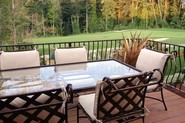Deck Railings Become Fun and Exciting
by Paul Bianchina, Inman News
 Deck railings can do a lot for the appearance and especially the safety of any outdoor deck. So when designing and building your new deck, there are a number of things to take into consideration.
Deck railings can do a lot for the appearance and especially the safety of any outdoor deck. So when designing and building your new deck, there are a number of things to take into consideration.
MEETING THE BUILDING CODES
The first thing you want to determine is what building codes apply to your deck railing project. With most codes, a railing is required if the top surface of the decking boards is 30 inches or more above grade, and in some jurisdictions the height is even lower. If you are building a deck on sloping ground, only that portion that is higher then 30 inches is typically required to have a railing, but from the standpoint of both aesthetics and structural integrity, it is usually preferable to extend the railing around the entire deck.
Another code consideration is the height of the railing itself, which typically is required to be 36 to 42 inches high. Where your railing falls within this range is a matter of preference, and while 36 inches is probably the most common, you might want to try hanging a piece of string at a couple of different heights to see if one height feels better than another.
The last code consideration is the spacing between the rail’s components. In order to protect small children from potential danger, most building codes now require that the spacing between rail parts such as the vertical pickets or between the bottom horizontal rail and the top of the deck be constructed so that a sphere no larger than 4 inches in diameter can pass between them.
MATERIALS
There are lots of fun and exciting possibilities for the materials you choose for your deck railing. As decks have continued to increase in popularity in recent years, more and more options have come on the market, and many are designed for quick and easy installation by pros and homeowners alike. You can also readily mix and match materials to get just the look you want.
Wood: Wood of course is a perennial favorite. Cedar, redwood, teak and other woods are all great choices for a deck, and are readily available in sizes that include 4-by-4 inches for support posts, 2-by-6 and 2-by-4 for rails and caps, 2-by-2 inches for pickets, and 1-by-1 to 1-by-12 for trim. For strength, appearance and safety, look for wood that is straight and solid, with a minimal number of knots and other defects.
Metal: Metal deck railing components can easily be found in a wide variety of materials, colors, sizes and shapes to fit the look of any deck. For example, there are aluminum deck railing components that allow you to construct an entire railing system out of easy-care aluminum in several different styles and colors. Or you might opt for aluminum tubes that fit into wooden upper and lower railings to create an attractive and very practical railing system.
There are an increasing number of metal railing components that really let you dress up a deck. You might want to check out pre-bent balusters made from aluminum flat stock in various colors that simply screw to wood railings, or go all out with a complete powder-coated steel balcony panel featuring trees, elk and other designs. For a look at these and other components, try a visit to www.rockler.com.
Cables: Stainless steel cables can be used with wood or metal supports to create a railing system that is both strong and attractive. The system is relatively easy to install for a do-it-yourselfer, following the manufacturer’s specific instructions. You can check out the system on the Web at www.cablerail.com.
Glass: Got a million-dollar view that you can’t bring yourself to obscure with a deck railing? Glass, combined with wood or aluminum in various configurations, offers yet another option for creating a safe and solid railing system that keeps the view open and kids enclosed. Glass must be tempered, and needs to meet building code requirements for thickness and resistance to wind load, so be sure to check with your local building officials for all the specifics.
Remodeling and repair questions? E-mail Paul at [email protected].
What’s your opinion? Leave your comments below or send a letter to the editor. To contact the writer, click the byline at the top of the story. Copyright 2008 Inman News
See another Paul Bianchina feature, Don’t Clean Deck With Pressure Washer.
Check out our green feature, Choosing a Deck Stain: Aesthetics vs. Durability.
American Apartment Owners Association offers discounts on products and services related to your commercial housing investment including REAL ESTATE FORMS, tenant debt collection, tenant background checks, insurance and financing. Find out more at www.joinaaoa.org.
To subscribe to our blog, click here.















 Accessibility
Accessibility